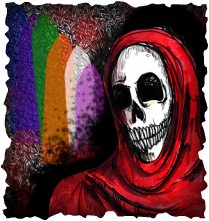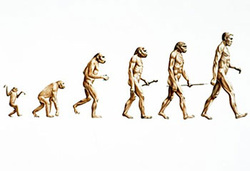"The main conclusion arrived at in this work, namely, that man is descended from some lowly organized form, will, I regret to think, be highly distasteful to many. But there can hardly be a doubt that we are descended from barbarians."
-- Charles Darwin. The Descent of Man, 1871
Evolution: Earliest Theories
Pre-Darwinism
The ideas of evolution, and the thoughts of there being another form of creation besides God took very many people by surprise before the Darwinism took a huge role in society's opinions. At the beginning of the 19th century, the scientist Jean-Baptiste Lamark (1744-1829) had ideas about biological processes and change, that actually turned out to be wrong. Lamark proposed that microscopic organisms formed spontaneously and gradually evolved over time. Lamark also incorrectly stated that organisms then continued to evolve through the idea of inheritance of acquired traits. Although Lamark was somewhat discredited, his thought of the existence of earlier life forms remained, allowing the opportunity for scientists to branch off from that idea.
Darwinism and Natural Selection
-Natural Selection is the process in which certain biological traits become more or less common in a population due to certain factors.
Darwin stated that there is variation among species. He also stated that competition exists between species due to a scarcity of resources. This competition leads to the survival of some species and the death of other, therefore, allowing some species to have advantageous variations which leads to a higher reproduction rate. This results in overall species adaptations, therefore a change in species, and an overall evolutionary change.
Social Darwinism
Social Darwinism, a term used for the competition, or rather the natural selection, of humans came about in the second half of the 19th Century. Although Darwin proposed natural selection between plants and animals in his book "The Origins of Species," he also believed the same interaction occurred throughout the human race as well. Social Darwinism really came about when Darwin published the book "The Descent of Man" in 1871. Once this book was published, ideas such as "the survival of the fittest" and "dog-eat-dog" world came about, along with the idea of hereditarianism and physical human changes due to environmental factors.
The ideas of evolution, and the thoughts of there being another form of creation besides God took very many people by surprise before the Darwinism took a huge role in society's opinions. At the beginning of the 19th century, the scientist Jean-Baptiste Lamark (1744-1829) had ideas about biological processes and change, that actually turned out to be wrong. Lamark proposed that microscopic organisms formed spontaneously and gradually evolved over time. Lamark also incorrectly stated that organisms then continued to evolve through the idea of inheritance of acquired traits. Although Lamark was somewhat discredited, his thought of the existence of earlier life forms remained, allowing the opportunity for scientists to branch off from that idea.
Darwinism and Natural Selection
-Natural Selection is the process in which certain biological traits become more or less common in a population due to certain factors.
Darwin stated that there is variation among species. He also stated that competition exists between species due to a scarcity of resources. This competition leads to the survival of some species and the death of other, therefore, allowing some species to have advantageous variations which leads to a higher reproduction rate. This results in overall species adaptations, therefore a change in species, and an overall evolutionary change.
Social Darwinism
Social Darwinism, a term used for the competition, or rather the natural selection, of humans came about in the second half of the 19th Century. Although Darwin proposed natural selection between plants and animals in his book "The Origins of Species," he also believed the same interaction occurred throughout the human race as well. Social Darwinism really came about when Darwin published the book "The Descent of Man" in 1871. Once this book was published, ideas such as "the survival of the fittest" and "dog-eat-dog" world came about, along with the idea of hereditarianism and physical human changes due to environmental factors.
Evolution Seen in Poe's Works
MURDERS IN THE RUE MORGUE

In the story, "Murders in the Rue Morgue," Poe publishes what becomes an infamous story line for the next century. Poe establishes what has become the murder-mystery series, a Sherlock-Holmes in the making, and displays his cunning wit with his main character Detective Dupin. With there being an unsolved murder in the rue morgue, Detective Dupin seems to be the only one who uses his detailed observation and qualitative analysis to solve the case. Surprisingly, in the end, the murderer turns out to be an orangutan.
The fact that this story strays away from society's original view of a murder mystery, Poe is able to spark the imagination as well as portray his underlying message of his interesting incorporation of an orangutan. The Murders in the Rue Morgue portrays the limits of the human and the bounds of human ability. During the detective case, the mental capability of the human detectives is very restrained. The only person who seems to be able to actually unravel the case is Detective Dupin. This idea portrays that the orangutan was able to out-smart humans, leaving the impression of humility upon the human race.
This ties in to Social Darwinism and when society doubts a lot about what Darwin has to say about human evolution. Poe makes a point that humans evolved from a species that were possibly smarter and more logical than the human race is today. Poe indirectly states that as humans evolve physically, there is a certain mentality that we have lost.
The fact that this story strays away from society's original view of a murder mystery, Poe is able to spark the imagination as well as portray his underlying message of his interesting incorporation of an orangutan. The Murders in the Rue Morgue portrays the limits of the human and the bounds of human ability. During the detective case, the mental capability of the human detectives is very restrained. The only person who seems to be able to actually unravel the case is Detective Dupin. This idea portrays that the orangutan was able to out-smart humans, leaving the impression of humility upon the human race.
This ties in to Social Darwinism and when society doubts a lot about what Darwin has to say about human evolution. Poe makes a point that humans evolved from a species that were possibly smarter and more logical than the human race is today. Poe indirectly states that as humans evolve physically, there is a certain mentality that we have lost.
MASQUE OF THE RED DEATH

In the Masque of the Red Death, a plague known as the Red Death is slowly sweeping the country. It's overall effect is a quick and painful death. In order to escape the gruesome consequences of the plague, Prince Prospero closes his gates of his castle and locks himself away where he invites his giddiest and most light-hearted of friends to join him. Prince Prospero proceeds to throw a huge masquerade, where he decorates the rooms of his castle in single colors. They were confined without the Red Death, or so it seemed. Eventually, "the Red Death held illimitable dominion over all". (Poe, 211)
The Masque of the Red Death takes a huge role in the explanation in the inability of human capability to outrun nature or natural processes. Poe also displays the idea of natural selection in this story as well. The fact that only the "most light-hearted" of people were chosen to join Prince Prospero, relates back to the idea that the most "fit" species are able to dominate and go on to reproduce while those who do not acquire advantageous qualities are left behind to die. Natural selection eventually occurs in the home of Prince Prospero as well. As time moves forward, "the giddiest grew pale" and slowly a figure in a Red Masque starts to make way through the crowd until Prince Prosper is found dead in the last room, representing an overall environmental domination and desecration of a species.
The Masque of the Red Death takes a huge role in the explanation in the inability of human capability to outrun nature or natural processes. Poe also displays the idea of natural selection in this story as well. The fact that only the "most light-hearted" of people were chosen to join Prince Prospero, relates back to the idea that the most "fit" species are able to dominate and go on to reproduce while those who do not acquire advantageous qualities are left behind to die. Natural selection eventually occurs in the home of Prince Prospero as well. As time moves forward, "the giddiest grew pale" and slowly a figure in a Red Masque starts to make way through the crowd until Prince Prosper is found dead in the last room, representing an overall environmental domination and desecration of a species.

